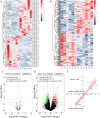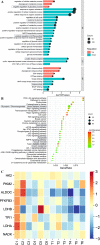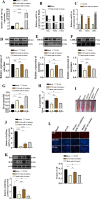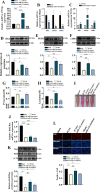Follicular fluid-derived exosomal miR-143-3p/miR-155-5p regulate follicular dysplasia by modulating glycolysis in granulosa cells in polycystic ovary syndrome
- PMID: 35534864
- PMCID: PMC9082924
- DOI: 10.1186/s12964-022-00876-6
Follicular fluid-derived exosomal miR-143-3p/miR-155-5p regulate follicular dysplasia by modulating glycolysis in granulosa cells in polycystic ovary syndrome
Erratum in
-
Correction: Follicular fluid-derived exosomal miR-143-3p/miR-155-5p regulate follicular dysplasia by modulating glycolysis in granulosa cells in polycystic ovary syndrome.Cell Commun Signal. 2022 Aug 1;20(1):116. doi: 10.1186/s12964-022-00938-9. Cell Commun Signal. 2022. PMID: 35915462 Free PMC article. No abstract available.
Abstract
Objective: Polycystic ovary syndrome (PCOS) is characterized by follicular dysplasia. An insufficient glycolysis-derived energy supply of granulosa cells (GCs) is an important cause of follicular dysplasia in PCOS. Follicular fluid (FF) exosomal microRNAs (miRNAs) have been proven to regulate the function of GCs. In this study, exosomes extracted from clinical FF samples were used for transcriptome sequencing (RNA-seq) analysis, and a human ovarian granulocyte tumour cell line (KGN cells) was used for in vitro mechanistic studies.
Methods and results: In FF exosomal RNA-seq analysis, a decrease in glycolysis-related pathways was identified as an important feature of the PCOS group, and the differentially expressed miR-143-3p and miR-155-5p may be regulatory factors of glycolysis. By determining the effects of miR-143-3p and miR-155-5p on hexokinase (HK) 2, pyruvate kinase muscle isozyme M2 (PKM2), lactate dehydrogenase A (LDHA), pyruvate, lactate and apoptosis in KGN cells, we found that upregulated miR-143-3p expression in exosomes from the PCOS group inhibited glycolysis in KGN cells; knockdown of miR-143-3p significantly alleviated the decrease in glycolysis in KGN cells in PCOS. MiR-155-5p silencing attenuated glycolytic activation in KGN cells; overexpression of miR-155-5p significantly promoted glycolysis in KGN cells in PCOS. In this study, HK2 was found to be the mediator of miR-143-3p and miR-155-5p in FF-derived exosome-mediated regulation of glycolysis in KGN cells. Reduced glycolysis accelerated apoptosis of KGN cells, which mediated follicular dysplasia through ATP, lactate and apoptotic pathways.
Conclusions: In conclusion, these results indicate that miR-143-3p and miR-155-5p in FF-derived exosomes antagonistically regulate glycolytic-mediated follicular dysplasia of GCs in PCOS. Video Abstract.
Keywords: Exosomes; Glycolysis; HK2; Polycystic ovary syndrome; miR-143-3p; miR-155-5p.
© 2022. The Author(s).
Conflict of interest statement
None.
Figures








Similar articles
-
Follicular fluid-derived extracellular vesicles miR-34a-5p regulates granulosa cell glycolysis in polycystic ovary syndrome by targeting LDHA.J Ovarian Res. 2024 Nov 13;17(1):223. doi: 10.1186/s13048-024-01542-w. J Ovarian Res. 2024. PMID: 39538292 Free PMC article.
-
Follicular Fluid-Derived Exosomal MicroRNA-18b-5p Regulates PTEN-Mediated PI3K/Akt/mTOR Signaling Pathway to Inhibit Polycystic Ovary Syndrome Development.Mol Neurobiol. 2022 Apr;59(4):2520-2531. doi: 10.1007/s12035-021-02714-1. Epub 2022 Jan 29. Mol Neurobiol. 2022. PMID: 35092573
-
PCOS follicular fluid derived exosomal miR-424-5p induces granulosa cells senescence by targeting CDCA4 expression.Cell Signal. 2021 Sep;85:110030. doi: 10.1016/j.cellsig.2021.110030. Epub 2021 Apr 28. Cell Signal. 2021. PMID: 33930499
-
Exosomal Communication Between Cumulus-Oocyte Complexes and Granulosa Cells: A New Molecular Axis for Oocyte Competence in Human-Assisted Reproduction.Int J Mol Sci. 2025 Jun 3;26(11):5363. doi: 10.3390/ijms26115363. Int J Mol Sci. 2025. PMID: 40508172 Free PMC article. Review.
-
The Whisper of the Follicle: A Systematic Review of Micro Ribonucleic Acids as Predictors of Oocyte Quality and In Vitro Fertilization Outcomes.Cells. 2025 May 27;14(11):787. doi: 10.3390/cells14110787. Cells. 2025. PMID: 40497963 Free PMC article. Review.
Cited by
-
miR-143-3p Promotes Ovarian Granulosa Cell Senescence and Inhibits Estradiol Synthesis by Targeting UBE2E3 and LHCGR.Int J Mol Sci. 2023 Aug 8;24(16):12560. doi: 10.3390/ijms241612560. Int J Mol Sci. 2023. PMID: 37628741 Free PMC article.
-
Upregulation of PD-L1 contributes to improving the apoptosis of granulosa cells via the PI3K/AKT pathway in PCOS.J Assist Reprod Genet. 2025 Feb;42(2):611-625. doi: 10.1007/s10815-024-03327-y. Epub 2024 Dec 11. J Assist Reprod Genet. 2025. PMID: 39663282 Free PMC article.
-
Human placental mesenchymal stem cells ameliorates premature ovarian insufficiency via modulating gut microbiota and suppressing the inflammation in rats.PLoS One. 2025 Mar 5;20(3):e0313763. doi: 10.1371/journal.pone.0313763. eCollection 2025. PLoS One. 2025. PMID: 40043087 Free PMC article.
-
The Role of MicroRNA, Long Non-Coding RNA and Circular RNA in the Pathogenesis of Polycystic Ovary Syndrome: A Literature Review.Int J Mol Sci. 2024 Jan 11;25(2):903. doi: 10.3390/ijms25020903. Int J Mol Sci. 2024. PMID: 38255975 Free PMC article. Review.
-
Circulating Cell Free microRNAs in Women with Polycystic Ovary Syndrome: Advancing Towards Biomarker Discovery and Therapeutic Targets.Reprod Sci. 2025 Jul;32(7):2137-2179. doi: 10.1007/s43032-025-01872-0. Epub 2025 May 29. Reprod Sci. 2025. PMID: 40439880 Review.
References
-
- Alvarez-Blasco F, Martínez-García MA, Luque-Ramírez M, Parraza N, San Millán JL, Escobar-Morreale HF. Role of haptoglobin in polycystic ovary syndrome (PCOS), obesity and disorders of glucose tolerance in premenopausal women. PLoS ONE. 2009;4:5606. doi: 10.1371/journal.pone.0005606. - DOI - PMC - PubMed
Publication types
MeSH terms
Substances
LinkOut - more resources
Full Text Sources
Medical
Miscellaneous

